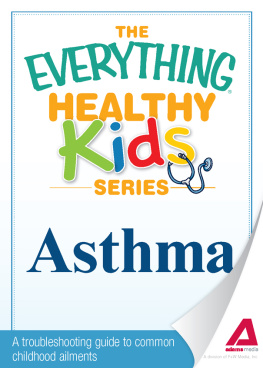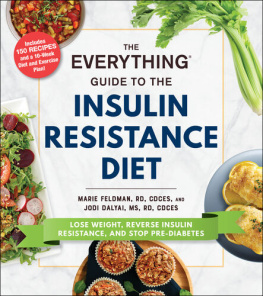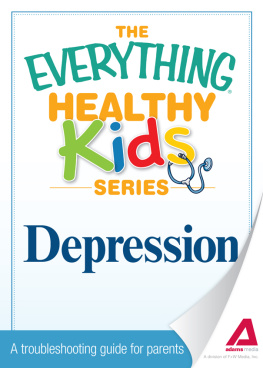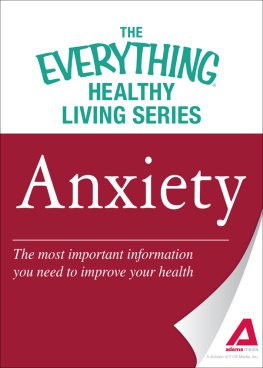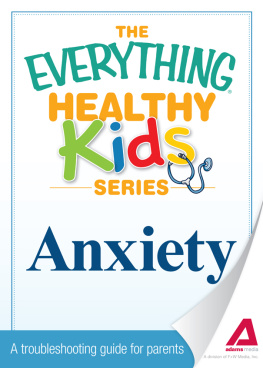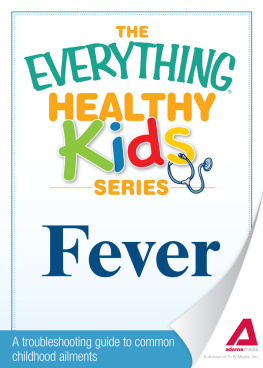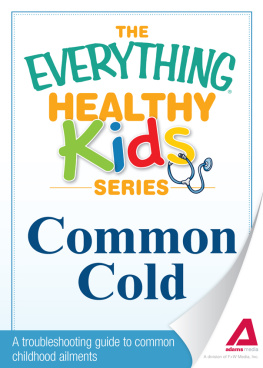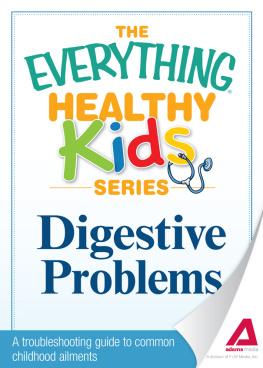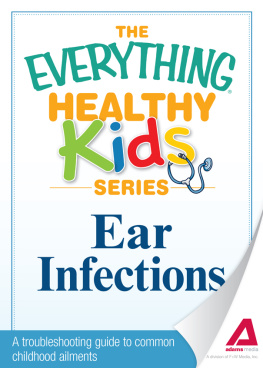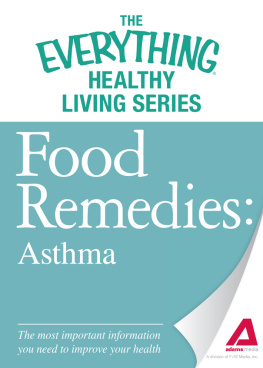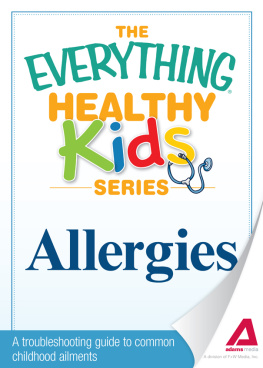Adams Media, a division of F+W Media, Inc.
For more than 10 years, millions of readers have trusted the bestselling Everything series for expert advice and important information on parenting and health topics ranging from pregnancy and postpartum care to asthma, dyslexia, and juvenile diabetes. Packed with the most recent, up-to-date data, Everything guides help you get the right diagnosis, choose the best doctor, and find the treatment options that work for your child.
The Everything Healthy Kids Series books are concise guides, focusing on only the essential information you need. Whether youre looking for information on how to treat ailments in children from infants to teenagers, advice on raising happy, well-adjusted kids, or suggestions for how to get your child to eat the right foods, theres an Everything Healthy Kids Book for you.
Asthma
Today, many children with asthma can deeply inhale and release their breaths slowly to create soap bubbles or scatter milky white dandelions seeds or cool their hot soups. They dont cough, nor do they wheeze. With new medications and new knowledge that sheds light on how to control asthma, they almost take for granted what even a generation or two before them couldnt fully imagine: Safely controlling their asthma by reducing constriction and inflammation of their airways to do almost anything they want.
But theres a flip side to this picture. Many other children with asthma perhaps even friends of those children who are controlling their asthma symptoms well find themselves excusing themselves from gym class for fear of triggering their asthma symptoms. Or, maybe they have become regulars at the local hospitals emergency room for when they have one of their frequent asthma flare-ups.
Today in the United States, an estimated 6.5 million children under age eighteen (almost 9 percent of the population) are now diagnosed with asthma. This rate has more than doubled since 1980, according to the Centers for Disease Control and Prevention. Its now the most common chronic childhood disease in the country.
But, despite the medical inroads that have been made in asthma treatment and control, many children in this growing population are still finding it hard to breathe. Theyre continuing to cough and wheeze during the day, and sleep uncomfortably through the night. Many dont have an asthma action plan or theyre not sure how to use a peak flow meter or inhaler correctly. These children are letting asthma symptoms manage them instead of them managing it.
Parents know that its a tough job getting on top of asthma trying to monitor symptoms or figure out if those prescribed medications are doing their jobs. Oftentimes, it means working with a reluctant child who hates being different from friends or siblings.
Theres no easy answer especially working with a health care system that can be fragmented and short of time when it comes to communicating effectively. But you dont have to let that control you you can control it by asking physicians and health care providers to partner with you and answer your questions about how to best manage your childrens asthma.
As you are seeing, medical science has moved along quickly to find better ways to treat and manage asthma symptoms. But sometimes science gets ahead of what you can practically do every day to help your children understand what asthma is and how they can live with it and control it.
The aim of Asthma is to let you know that children with asthma can learn to confidently manage their condition with you and enjoy everything life has in store for them.
If youd like to learn more about children and asthma, check out The Everything Parents Guide to Children with Asthma , available in print (978-1-59869-430-7) and eBook (978-1-60550-207-6) formats.
Asthma Defined
To understand asthma, it helps to understand the word asthma itself, which comes from the Greek word meaning to pant. While the disease has ancient roots, its still very active today. New treatments and new approaches toward asthma have changed the way people view asthma. But when your child is diagnosed with asthma, you worry. But now that you have more information at your fingertips, are you doing all that you can to help the child understand what asthma is and how he can better manage it?
How Does Asthma Occur?
Ask your child what he least likes about asthma, and hell likely respond that its when it seems hard for him to breathe sometimes maybe like trying to suck air from a straw. Or maybe he will complain that his chest hurts or that he cant catch his breath. It may seem scary for him and you.
Asthma affects the bronchial tubes, which are also called airways. As your child probably knows, when he breathes normally, air is pulled into his nose and mouth. It then goes into the windpipe or trachea, through the airways, and into the lungs. In the lungs, oxygen is delivered that goes through the blood stream and out to the rest of the body. Meanwhile, carbon dioxide is removed and then exhaled through the airways back out again.
Fact
Individuals with asthma have airways that become inflamed. In addition to producing a thick layer of mucus, they swell and become sensitive to certain stimuli, called triggers, such as viruses that cause colds, mold, pollen, household dust, exercise, fragrances, air pollutants, secondhand tobacco smoke, or wood smoke. This reaction causes the smooth muscles that line the airways to constrict making it difficult for air to move in and out of the lungs.
With asthma, breathing difficulties can happen periodically. When this occurs, your child is having what can be referred to as an asthma attack, flare-up, or episode. Without a short-term quick-relief medication, these attacks can last for several hours.
Between the attacks, your childs breathing can seem normal. Other times, though, it may be accompanied by various symptoms such as coughing, wheezing, or nasal congestion. Sometimes, it may only appear when doing physical exercise or, more commonly, it can appear during the night disrupting your childs sleep.
Many daily long-term control medications have been introduced in recent years to help prevent the swelling and inflammation of those airways and stop the occurrence of asthma flare-ups.
Why More Asthma Cases?
As the number of children with asthma continues to increase, a natural question you might have is why? The answer, though, may not be clear and has been the cause of much discussion inside and outside the medical and scientific communities.
Younger Patients
One part of the increase may be related to the number of infants and toddlers being diagnosed with asthma. For many years, the medical community believed that children younger than three years could not have asthma. Instead, their providers would diagnose them, for instance, with conditions such as wheezy bronchitis or an upper respiratory infection.
Today, it is known that even infants may exhibit repetitive symptoms that suggest an asthma diagnosis. And, the sooner they are treated, the sooner they can feel better and avoid possible lung damage in the future.
Also, through medical technology, more babies born at lower birth-weights are surviving. However, studies have shown that a lower birth weight may be associated with more respiratory symptoms and asthma during the childs younger years.

